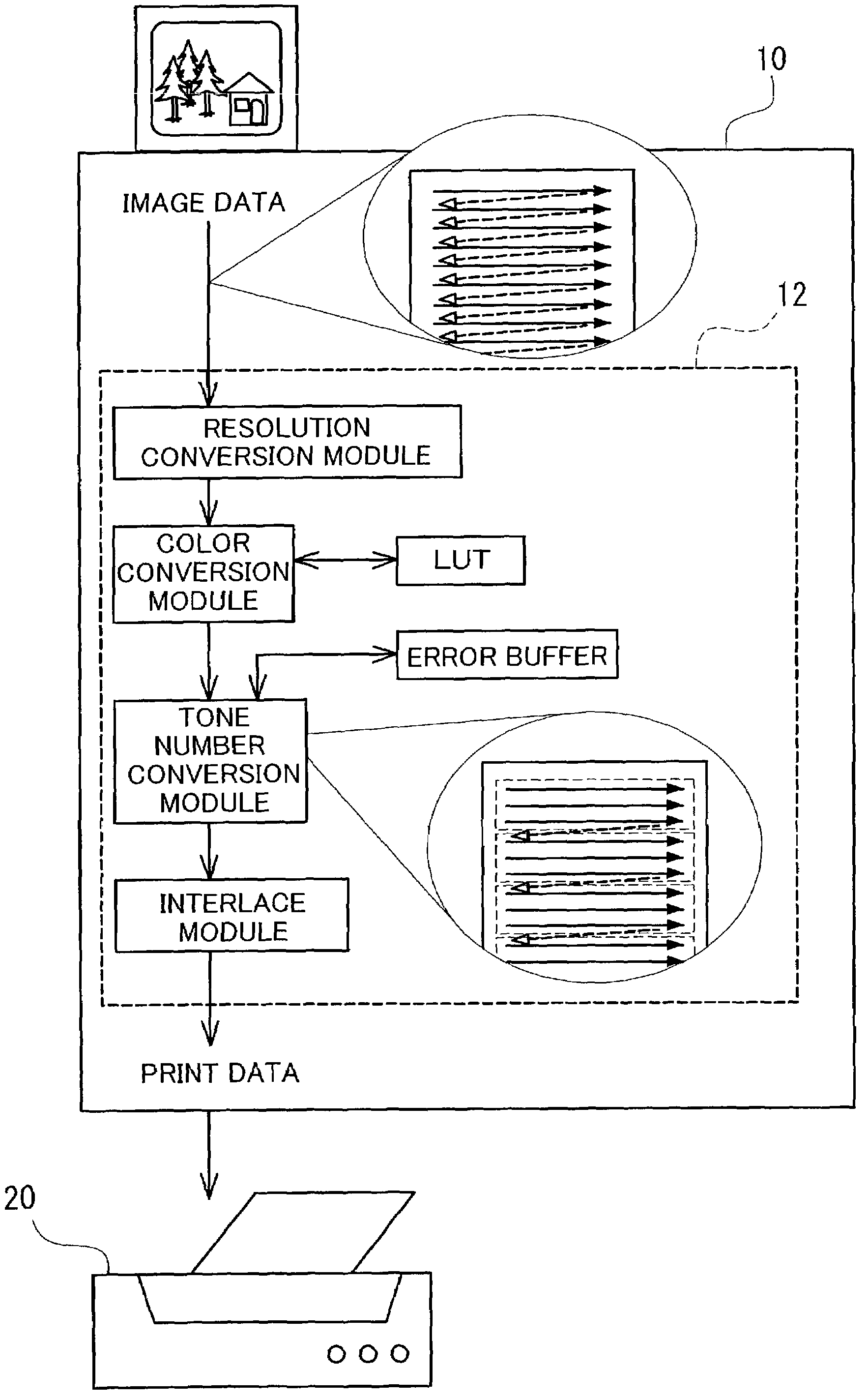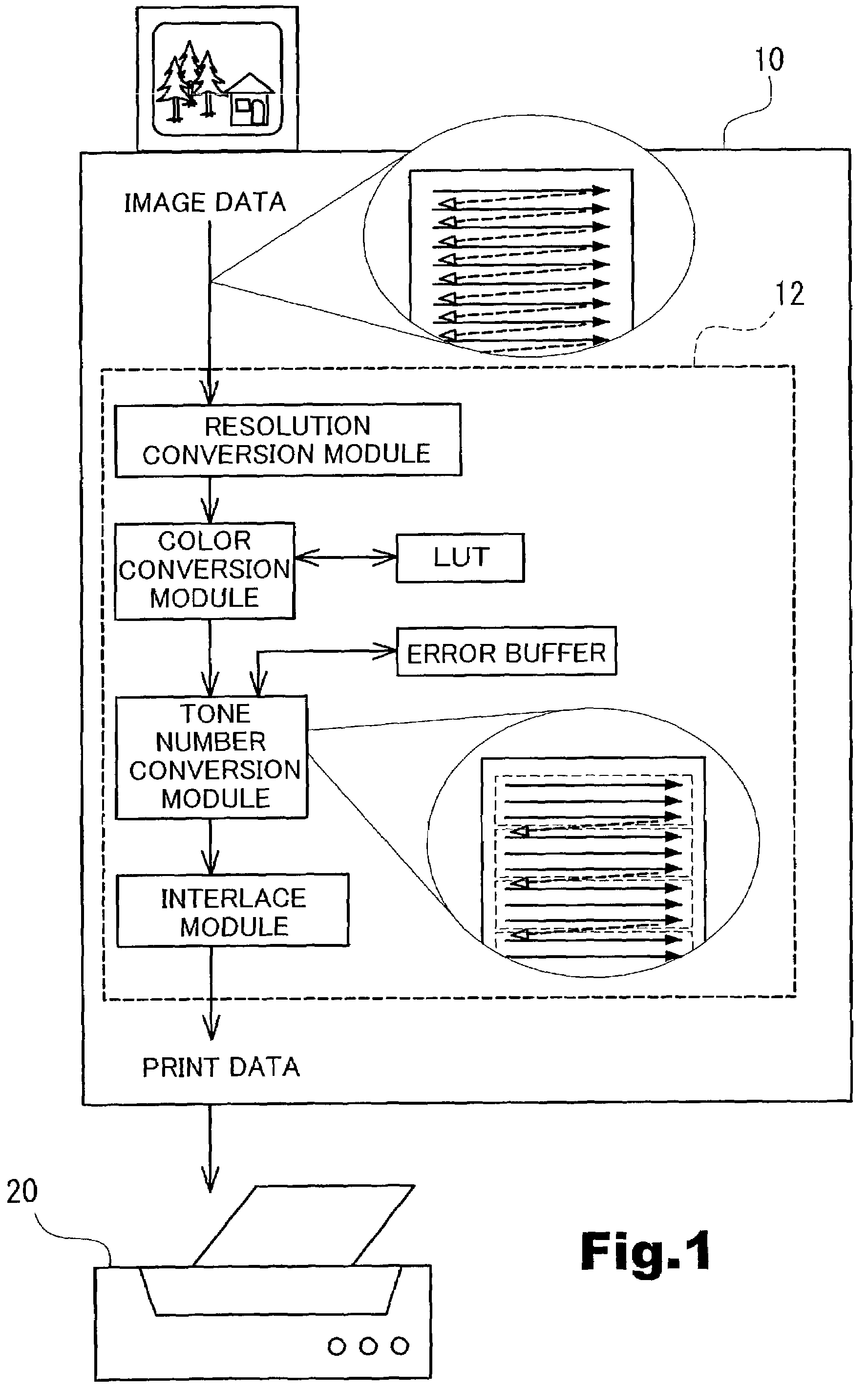Image processing device, printing control device, image processing method, and recorded medium
a technology of image processing and printing control, which is applied in the direction of image enhancement, digital output to print units, instruments, etc., can solve the problems of time-consuming, inability to conduct simultaneous dot on-off state determination for all pixels, and inability to quickly carry out dot on-off state determination, etc., to achieve the effect of shortening the processing tim
- Summary
- Abstract
- Description
- Claims
- Application Information
AI Technical Summary
Benefits of technology
Problems solved by technology
Method used
Image
Examples
first embodiment
B.
B-1. Apparatus Construction:
[0114]FIG. 2 is an explanatory drawing showing the construction of a printer 100 comprising the image processing apparatus of the first embodiment. The computer 100 is a conventional computer centered around a CPU 102, wherein a ROM 104 and a RAM 106 are interconnected via a bus 116. The CPU 102 comprises a processing unit that performs actual processing and multiple registers in which data is temporarily stored during processing. The data stored in the registers can be processed much more quickly than the data stored in the RAM 106.
[0115]A disk controller DDC 109 used to read data from a floppy disk 124 or a compact disk 126, a peripheral equipment interface P-I / F 108 used to send and receive data to and from peripheral equipment, a video interface V-I / F 112 used to drive a CRT 114 and the like are connected to the computer 100. A color printer 200 described below, a hard disk 118 and the like are connected to the P-I / F 108. Furthermore, if a digital c...
first modification
(1) First Modification
[0164]The description above involved the simplest possible example, wherein dot on-off state determination was conducted for two rasters in a parallel manner. However, the number of rasters that may be processed in a parallel manner is not limited to two, and may comprise three or more. FIG. 9 is an explanatory drawing showing a conceptual view of the situation in which dot on-off state determination is conducted for three rasters in a parallel manner. In FIG. 9, dot on-off state determination is conducted for the three rasters (i), (j) and (k) in a parallel manner. In order to avoid making the description unduly complex, the error diffusion matrix shown in FIG. 6(a) is used here, as in the case shown in FIG. 7.
[0165]The hatched lines in the raster (i) and the raster (k) indicate that diffused errors allocated to these raster pixels are stored in the RAM 106. The numbers enclosed by circles located inside the pixels of the rasters (i), (j) and (k) indicate the ...
second embodiment
C.
[0178]In the various embodiments described above as the tone number conversion routine of the first embodiment, the binarization error occurring during dot on-off state determination for the target pixel was diffused into and stored in connection with surrounding pixels in accordance with error diffusion coefficients set in an error diffusion matrix. This means that the method of the first embodiment can be presumed to conform to the so-called error diffusion method. Dot on-off state determination for multiple rasters can also be conducted in a parallel manner using a method conforming to the so-called average error minimum method. The tone number conversion routine of this second embodiment will be explained below.
C-1. Tone Number Conversion Routine of the Second Embodiment:
[0179]FIG. 13 is an explanatory drawing to explain in a conceptual manner the principle by which dot on-off state determination is conducted quickly through parallel processing of multiple rasters in the tone ...
PUM
 Login to View More
Login to View More Abstract
Description
Claims
Application Information
 Login to View More
Login to View More - R&D
- Intellectual Property
- Life Sciences
- Materials
- Tech Scout
- Unparalleled Data Quality
- Higher Quality Content
- 60% Fewer Hallucinations
Browse by: Latest US Patents, China's latest patents, Technical Efficacy Thesaurus, Application Domain, Technology Topic, Popular Technical Reports.
© 2025 PatSnap. All rights reserved.Legal|Privacy policy|Modern Slavery Act Transparency Statement|Sitemap|About US| Contact US: help@patsnap.com



